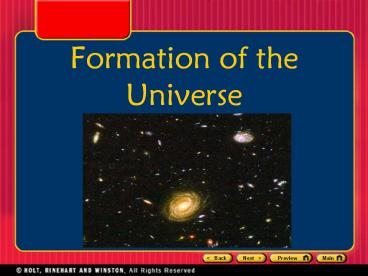Formation of the Universe - PowerPoint PPT Presentation
Title: Formation of the Universe
1
Formation of the Universe
2
Formation of the Universe
- Cosmology is the study of the origin,
properties, processes, and evolution of the
universe. - Universal Expansion
- Galaxy Movement To understand how the universe
formed, scientists study the movement of
galaxies. - A Raisin-Bread Model The universe, like the
rising raisin bread dough, is expanding. Think of
the raisins in the dough as galaxies. As the
universe expands, the galaxies move farther apart.
3
Formation of the Universe
The Big Bang Theory
- A Tremendous Explosion The theory that the
universe began with a tremendous explosion is
called the big bang theory. - Cosmic Background Radiation In 1964, two
scientists using a huge antenna accidentally
found radiation coming from all directions in
space. One explanation for this radiation is that
it is cosmic background radiation left over from
the big bang.
4
Formation of the Universe
The BIG BANG
5
The Structure of the Universe
6
Formation of the Universe
How Old Is the Universe?
- Age of the Universe Scientist use to methods
to study the age of the universe. - By measuring the distance between Earth and
various galaxies, scientists can predict the rate
of expansion and calculate the age of the
universe at about 13.77 billion years. - Because the universe must at least be as old as
the oldest stars it contains, the ages of the
stars provide a clue to the age of the universe.
7
Formation of the Universe
A Forever Expanding Universe
- The expansion of the universe depends on the
amount of matter it contains. A large enough
quantity of matter would cause gravity to stop
the expansion. The universe could start
collapsing. - Scientist now think that there may not be enough
matter in the universe, so the universe would
continue to expand forever and become cold and
dark as all the stars die.
8
Galaxies
9
Galaxies
- A galaxy is a collection of stars, dust, and gas
held together by gravity. - Types of Galaxies
- Spiral Galaxies make up 75 of all galaxies and
have a bulge at the center with spiral arms. - The Milky Way Astronomers think that our solar
system is in a spiral galaxy.
10
Galaxies
Types of Galaxies, continued
- Elliptical Galaxies About one-third or 20 of
all galaxies are simply massive blobs of stars.
These are called elliptical galaxies. - Irregular Galaxies Galaxies, about 5 of all
galaxies that do not fit into any other class are
called irregular galaxies.
11
(No Transcript)
12
(No Transcript)
13
(No Transcript)
14
Galaxies
Contents of Galaxies
- Gas Clouds A large clouds of gas and dust in
interstellar space is called a nebula. - Star Clusters A globular cluster is a tight
group of stars that looks like a ball and
contains up to 1 million stars. - An open cluster is a group of stars that are
close together relative to surrounding stars.
15
Galaxies
16
Galaxies
Origin of the Galaxies
- Because if takes light time to travel through
space, looking at distant galaxies reveals what
early galaxies looked like. - Quasars A very luminous, starlike object that
generates energy at a high rate is called a
quasar. Some scientists think that quasars may
be the core of young galaxies that are in the
process of forming.
17
Heliocentric vs. GeocentricThe structure of the
Universe
18
Astronomy The Original Science
Whos Who of Early Astronomy
- Ptolemy An Earth-Centered Universe Ptolemy
thought that the Earth was at the center of the
universe and that the other planets and the sun
revolved around the Earth. - Geocentric Model
19
Astronomy The Original Science
Whos Who of Early Astronomy
- Copernicus A Sun-Centered Universe Copernicus
thought the sun is at the center of the universe,
and all of the planetsincluding the Earthorbit
the sun. - Heliocentric Model































